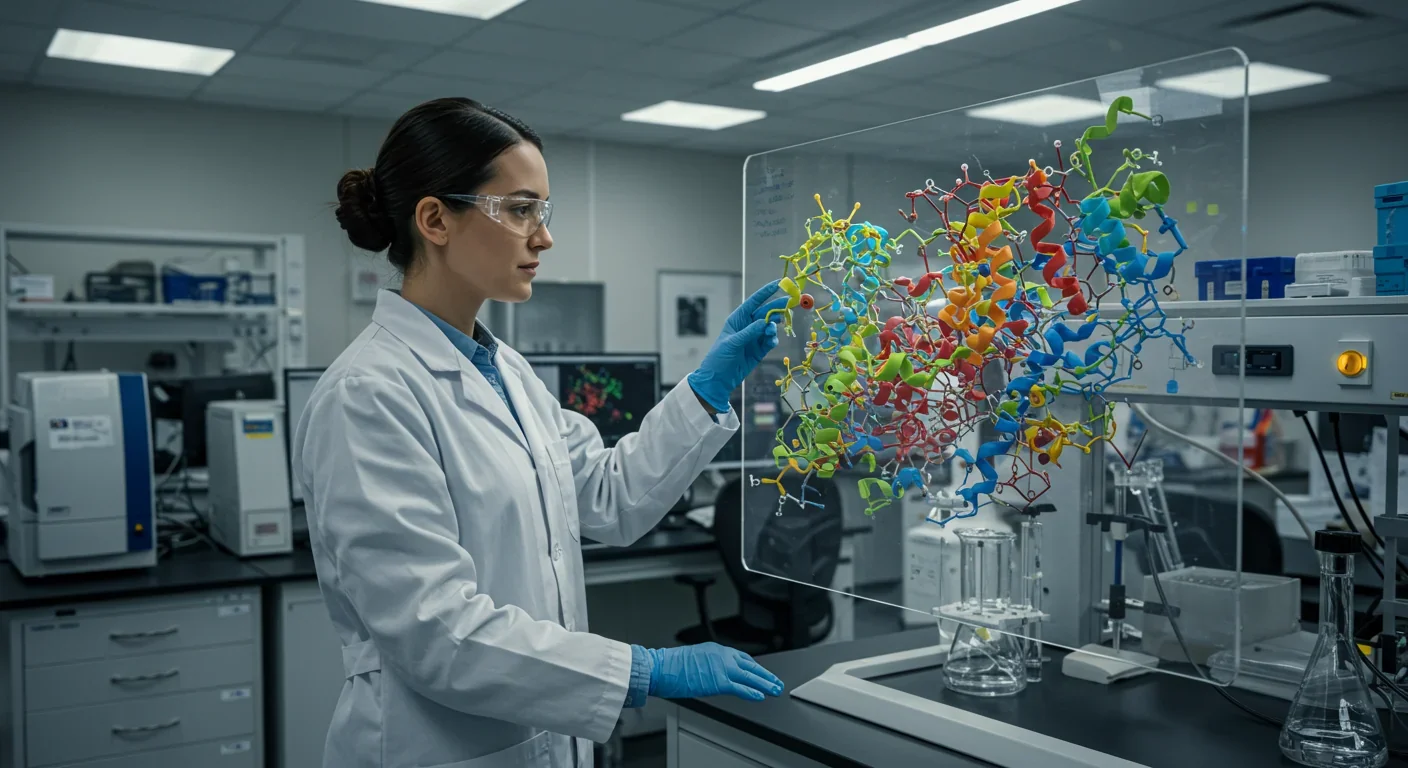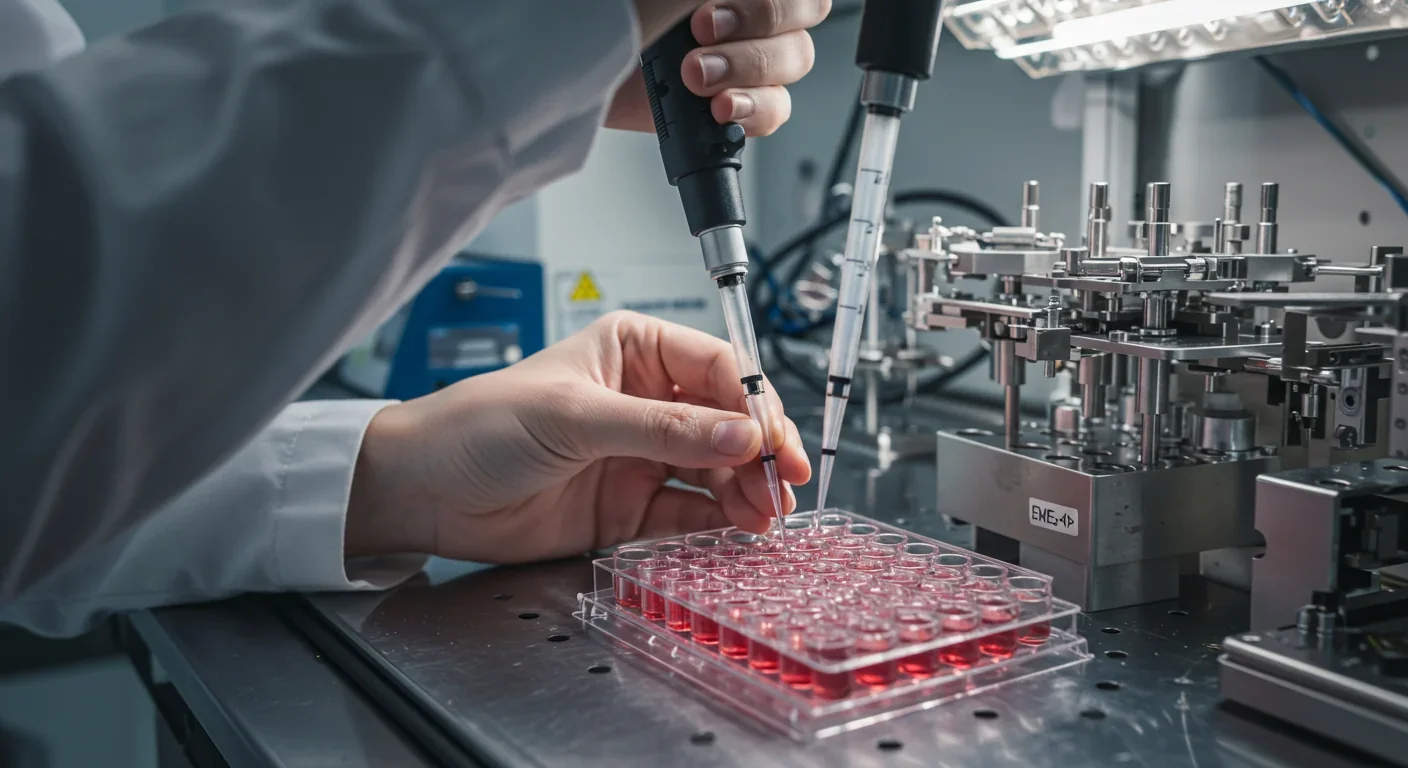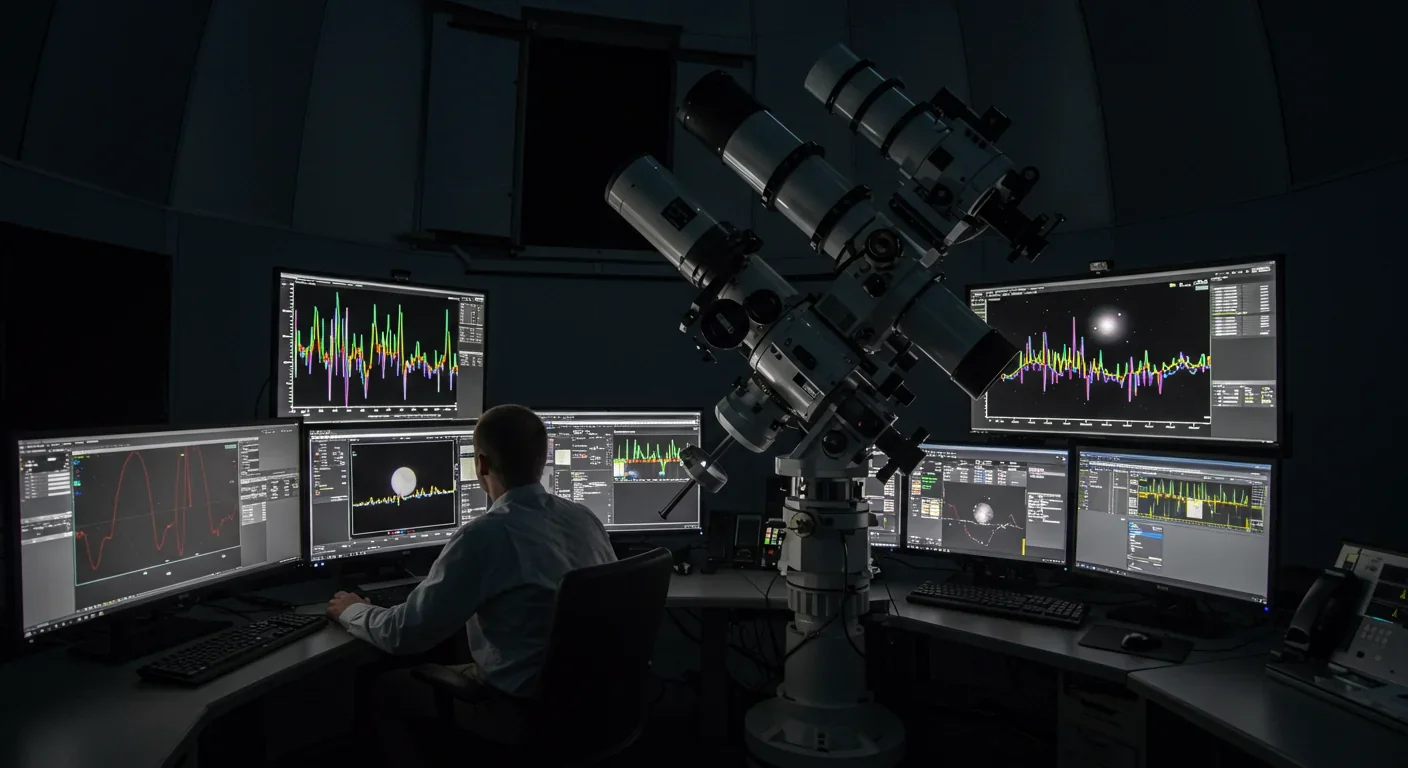Hidden Mold Mycotoxins Fueling Chronic Illness Epidemic

TL;DR: AI models like AlphaFold have solved the 50-year-old protein folding problem, enabling scientists to predict molecular structures in hours instead of years and accelerating drug discovery for diseases from COVID-19 to Alzheimer's to cancer.

By 2030, the average timeline for developing a new drug could shrink from over a decade to just months. That's not science fiction, it's the promise of AI-powered protein folding. What started as a computational challenge has become the foundation for a medical revolution, one where machines can predict molecular structures faster than any lab experiment. And it's already changing how we fight diseases that have plagued humanity for centuries.
In 2020, DeepMind's AlphaFold shocked the scientific world by solving protein folding, a problem that had stumped researchers for 50 years. Proteins are the workhorses of biology, executing nearly every function in your cells, from digesting food to fighting infections. But their power comes from their shape, and predicting how a chain of amino acids folds into a three-dimensional structure was brutally difficult.
AlphaFold changed that overnight. The AI system could predict protein structures with accuracy matching experimental methods, except it did so in hours instead of years. Within months of its release, researchers had mapped over 200 million protein structures, more than humanity had discovered in the previous century of biology combined.
This wasn't just about speed. Understanding protein structure unlocks the molecular basis of disease. When proteins misfold, they can cause devastating conditions. In Alzheimer's, abnormal protein accumulation creates toxic plaques that destroy brain cells. In Parkinson's, misfolded alpha-synuclein proteins spread through neural networks like a contagion. And in cancer, mutations alter protein shapes, turning normal cells into malignant ones.
AlphaFold gave scientists a map to navigate this molecular landscape. Researchers could suddenly see how proteins interact, where drugs might bind, and which mutations matter most. The implications were staggering because nearly every disease has a protein component, from rare genetic disorders to common killers like heart disease.
The first real-world test came faster than anyone expected. When SARS-CoV-2 emerged in early 2020, scientists needed to understand its spike protein, the molecular key it uses to invade human cells. Traditional methods would have taken months. AlphaFold and related AI systems predicted the structure in days.
That prediction became the blueprint for vaccine development. Moderna and BioNTech used structural data to design mRNA vaccines that taught immune systems to recognize the spike protein. The result? Safe, effective vaccines deployed in record time, saving millions of lives.
But COVID was just the beginning. Pharmaceutical companies realized AI could accelerate every stage of drug discovery. Isomorphic Labs, a DeepMind spinoff, is now partnering with major drugmakers to design molecules that bind precisely to disease targets. Insilico Medicine used AI to discover a drug candidate for pulmonary fibrosis in 18 months, a process that typically takes four to five years.
The secret lies in prediction accuracy. Modern AI models like AlphaFold3 can predict not just single protein structures but entire molecular complexes, showing how proteins interact with DNA, RNA, and small molecules. This capability opens new therapeutic possibilities because most drugs work by interfering with protein interactions.
How does AI see what microscopes can't? The answer involves deep learning, massive datasets, and evolutionary logic. AlphaFold was trained on hundreds of thousands of known protein structures, learning patterns between amino acid sequences and their final shapes. But it didn't just memorize examples. The system learned the physics of protein folding, understanding how chemical bonds, electrical charges, and molecular forces guide folding.
One key insight came from evolution. Proteins with similar sequences often have similar structures, even across different species. AlphaFold exploits this by comparing multiple sequence alignments, identifying conserved regions that hint at structural importance. It's like solving a jigsaw puzzle by looking at photos of similar completed puzzles.
The network architecture matters too. AlphaFold uses attention mechanisms, a neural network design that lets different parts of the model focus on different aspects of the problem simultaneously. One module might analyze local interactions between nearby amino acids, while another examines long-range contacts that bring distant parts of the chain together. These predictions are then refined iteratively, improving accuracy with each cycle.
Recent advances push even further. AlphaFold3 can model protein complexes with ligands, the small molecules that become drugs. It predicts how tightly they'll bind, which conformations are most stable, and where mutations might create resistance. This turns structure prediction into a design tool, letting researchers optimize molecules before synthesizing a single compound.

Traditional drug development is expensive, slow, and prone to failure. Only about 10% of candidates that enter clinical trials eventually reach patients, and the average cost exceeds $2.6 billion per approved drug. Much of that expense comes from early-stage research, where scientists screen thousands of compounds hoping to find one that works.
AI is inverting that model. Instead of random screening, researchers can now design drugs computationally. You start with a disease target, a protein whose activity you want to block or enhance. AI predicts its structure, identifies binding pockets, and generates molecules that fit like keys in a lock. Then you test only the most promising candidates, slashing both time and cost.
This approach is already producing results. Recursion Pharmaceuticals uses AI to analyze biological images, identifying cellular changes caused by disease and potential treatments. Exscientia combined AI design with automated synthesis, creating a drug candidate for obsessive-compulsive disorder that entered human trials in just 12 months.
The impact extends beyond speed. AI can tackle targets previously considered "undruggable," proteins with no obvious binding sites or unstable structures. These difficult targets include many cancer-causing proteins and components of infectious disease machinery. By predicting rare conformations or allosteric sites, locations distant from the active site that still influence function, AI opens new therapeutic avenues.
Alzheimer's, Parkinson's, and Huntington's disease share a common feature: proteins that fold incorrectly and accumulate in the brain. These misfolded proteins spread from cell to cell, corrupting healthy proteins in a process eerily similar to infection. For decades, targeting them has proven nearly impossible.
AI is changing that equation. Researchers at Johns Hopkins found that understanding misfolding pathways could reveal intervention points. In Parkinson's, alpha-synuclein proteins normally help neurons communicate. But mutations or cellular stress can cause them to misfold, clump together, and kill dopamine-producing cells.
Recent studies using AI-predicted structures identified exactly how this misfolding occurs and designed molecules that stabilize the correct form. In laboratory tests, these compounds prevented toxic aggregation, keeping neurons healthy even when exposed to disease triggers.
Alzheimer's presents a similar challenge. The disease involves two problem proteins: amyloid-beta, which forms plaques outside neurons, and tau, which creates tangles inside them. AI models have mapped both structures in unprecedented detail, revealing how they interact with cellular machinery and spread through the brain. This knowledge is guiding development of antibodies that clear plaques and small molecules that prevent tau aggregation.
Cancer is fundamentally a disease of mutated proteins. Normal cells have checkpoints that prevent uncontrolled growth, repair DNA damage, and trigger self-destruction when things go wrong. Cancers evade these safeguards by mutating key proteins, turning off the brakes while stepping on the gas.
The challenge is that every tumor is different. Two patients with lung cancer might have completely different sets of mutations, requiring personalized treatment strategies. AI makes this personalization possible by rapidly predicting how mutations alter protein function and identifying druggable targets unique to each patient's cancer.
One approach targets protein-protein interactions. Many cancer-driving proteins work in teams, forming complexes that promote growth and survival. AlphaFold3's ability to model these complexes lets researchers design molecules that disrupt pathological interactions while leaving healthy ones intact. This specificity could reduce side effects, a major limitation of current chemotherapy.
Immunotherapy represents another frontier. CAR-T cell therapy engineers a patient's immune cells to recognize and kill cancer, but designing effective receptors requires understanding how immune proteins bind to tumor markers. AI-predicted structures accelerate this process, enabling rapid development of personalized immunotherapies.
China, the United States, and Europe are locked in competition to dominate AI-driven drug discovery. Each region brings different strengths. American companies lead in AI algorithms and venture funding, with biotech hubs in Boston and San Francisco attracting top talent. DeepMind's partnership with the European Molecular Biology Laboratory ensures open access to AlphaFold predictions, democratizing the technology.
China has mobilized massive resources for AI healthcare. Companies like XtalPi and Insilico Medicine combine AI with robotic laboratories, creating fully automated drug discovery pipelines. Government investment in AI research and relaxed data-sharing regulations give Chinese firms advantages in training large models.
But competition also drives collaboration. When COVID struck, researchers globally shared protein structure data and AI models, accelerating vaccine development. Organizations like the Protein Data Bank serve as neutral repositories, ensuring scientists everywhere can access critical information. This open science ethos, where fundamental discoveries are shared freely, has been crucial to progress.
The equity question looms large. If AI slashes drug development costs, will those savings reach patients? Or will pharmaceutical companies capture the value, maintaining high prices? Countries with strong generic drug industries might leverage AI to produce affordable medicines faster, potentially disrupting traditional pharma business models.

The convergence of AI and biology is creating new career paths and skills demands. Computational biologists who can code and understand molecular mechanisms are in high demand. So are experts in machine learning who grasp the nuances of biological data, which is noisier and more complex than typical AI training sets.
Educational institutions are adapting. Universities now offer joint degrees in computer science and biology, and pharmaceutical companies are retraining chemists in computational methods. The ability to bridge disciplines, translating between the languages of biology, chemistry, physics, and computer science, has become a premium skill.
For patients, the protein age promises faster access to better treatments. Rare disease patients might benefit most because AI makes targeting obscure proteins economically viable. Conditions affecting only thousands of people worldwide, which historically attracted little research investment, could finally see therapeutic development.
But challenges remain. Predicting structure is only the first step. A drug must be safe, manufacturable, and deliverable to the right tissues. Clinical trials still take years and most candidates fail due to toxicity or lack of efficacy. AI can reduce early-stage attrition, but it can't eliminate the biological complexity of human disease.
Regulatory frameworks are evolving too. How should agencies evaluate AI-designed drugs? What validation is required for computational predictions? The FDA and EMA are developing guidelines, but the technology advances faster than policy. Ensuring safety while not stifling innovation requires careful balance, and different countries are taking different approaches.
The ethical dimension grows more complex as capabilities expand. If AI can predict how proteins fold, can it also design entirely new proteins with functions nature never created? That's already happening. Synthetic biology companies use AI to engineer proteins that produce biofuels, clean up pollution, or manufacture materials. These applications could transform industries, but they also raise biosafety questions about releasing novel organisms into the environment.
We're witnessing a fundamental shift in how humans interact with biology. For centuries, medicine meant observing nature and trying to harness what we found. Now we're becoming molecular designers, using AI to predict, optimize, and create at the atomic scale. The protein folding breakthrough isn't just about faster drug discovery. It's about acquiring a new capability, the power to see and manipulate the machinery of life itself.
That power comes with responsibility. The same AI that predicts therapeutic proteins could potentially design harmful ones. Dual-use research concerns prompt debates about publication restrictions and access controls. Most researchers favor openness, arguing that transparency and broad access produce better safety outcomes than secrecy. But the tension between enabling beneficial innovation and preventing misuse will persist.
The next decade will reveal whether AI can deliver on its promise of transforming medicine. Early successes with COVID vaccines and rapid candidate generation are encouraging, but major diseases like Alzheimer's remain stubbornly difficult. The difference between predicting a structure and curing a disease is vast, spanning molecular biology, pharmacology, clinical medicine, and human physiology.
Yet the momentum is undeniable. AI systems grow more capable each year, processing larger datasets and making more accurate predictions. Computing power continues expanding, enabling simulations of ever more complex biological systems. And crucially, collaboration between AI researchers and biologists deepens, creating tools that address real scientific problems rather than just demonstrating technical prowess.
What happens when drug discovery moves from years to months? Pharmaceutical development could become more iterative, with failures caught earlier and pivots happening faster. Diseases previously ignored due to small patient populations might attract investment as development costs fall. Personalized medicine could advance from concept to standard practice, with treatments tailored to individual genetic profiles.
The protein folding revolution shows how quickly scientific paradigms can shift. A problem considered unsolvable for half a century yielded to AI in a matter of years, and the implications cascade outward, touching drug discovery, synthetic biology, our understanding of disease, and humanity's relationship with the molecular world. We're not just predicting protein shapes anymore. We're learning to read and write the language of life itself, and that's a transformation whose consequences we're only beginning to comprehend.

Over 80% of nearby white dwarfs show chemical fingerprints of destroyed planets in their atmospheres—cosmic crime scenes where astronomers perform planetary autopsies using spectroscopy. JWST recently discovered 12 debris disks with unprecedented diversity, from glassy silica dust to hidden planetary graveyards invisible to previous surveys. These stellar remnants offer the only direct measurement of exoplanet interiors, revealing Earth-like rocky worlds, Mercury-like metal-rich cores, and ev...

Hidden mold in homes releases invisible mycotoxins—toxic chemicals that persist long after mold removal, triggering chronic fatigue, brain fog, immune dysfunction, and neurological damage. Up to 50% of buildings harbor mold, yet most mycotoxin exposure goes undetected. Cutting-edge airborne testing, professional remediation, and medical detox protocols can reveal and reverse this silent epidemic, empowering individuals to reclaim their health.

Data centers consumed 415 terawatt-hours of electricity in 2024 and will nearly double that by 2030, driven by AI's insatiable energy appetite. Despite tech giants' renewable pledges, actual emissions are up to 662% higher than reported due to accounting loopholes. A digital pollution tax—similar to Europe's carbon border tariff—could finally force the industry to invest in efficiency technologies like liquid cooling, waste heat recovery, and time-matched renewable power, transforming volunta...

Transactive memory is the invisible system that makes couples, teams, and families smarter together than apart. Psychologist Daniel Wegner discovered in 1985 that our brains delegate knowledge to trusted partners, creating shared memory networks that reduce cognitive load by up to 40%. But these systems are fragile—breaking down when members leave, technology overwhelms, or communication fails. As AI and remote work reshape collaboration, understanding how to intentionally build and maintain ...

Mass coral spawning synchronization is one of nature's most precisely timed events, but climate change threatens to disrupt it. Scientists are responding with selective breeding, controlled laboratory spawning, and automated monitoring to preserve reef ecosystems.

Your smartphone isn't just a tool—it's part of your mind. The extended mind thesis argues that cognition extends beyond your skull into devices, AI assistants, and wearables that store, process, and predict your thoughts. While 79% of Americans now depend on digital devices for memory, this isn't amnesia—it's cognitive evolution. The challenge is designing tools that enhance thinking without hijacking attention or eroding autonomy. From brain-computer interfaces to AI tutors, the future of co...

The 2017 "Attention Is All You Need" paper introduced transformer architecture, revolutionizing AI by replacing sequential processing with parallel attention mechanisms. Transformers now power ChatGPT, DALL-E, and virtually every major AI breakthrough, achieving superior performance while training faster than previous models. This shift created new career opportunities, raised concerns about bias and environmental impact, and fundamentally changed how machines—and humans—interact with informa...